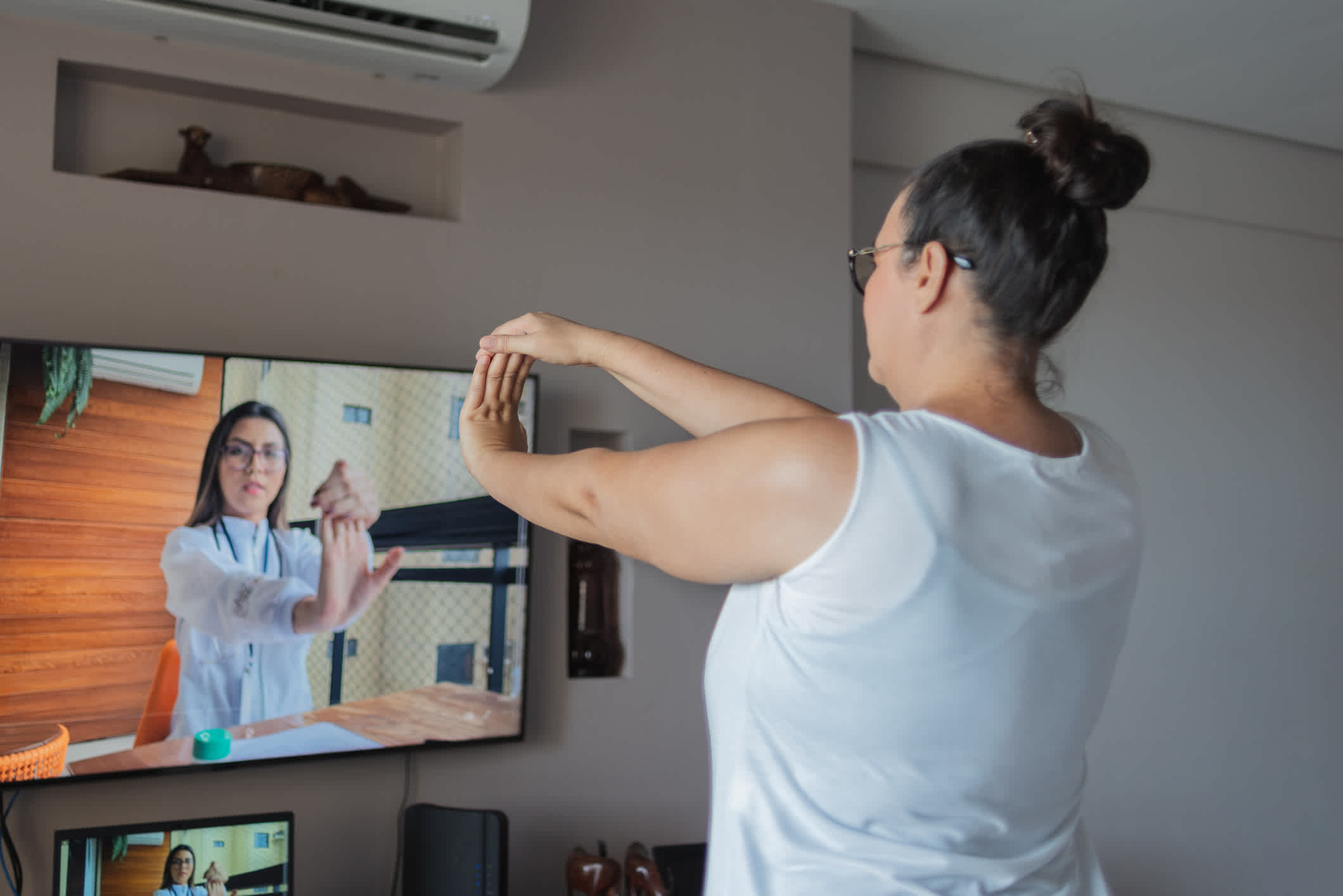What are Telehealth Services and What are the Benefits?
There has been a massive acceleration in the use of telehealth & interest in its benefits. ✓ Learn how telehealth services are shaping the future of healthcare.
- Hinge Health Learning Center
- Articles
- What are Telehealth Services and What are the Benefits?
Our Hinge Health Experts
Hinge Health
The Difference Between Telehealth, Telemedicine, and Digital Clinics
The digitization of health services is in full swing. When the COVID-19 pandemic forced millions to stay home, the healthcare industry reacted by accelerating the adoption of telehealth technology. Approximately 46% of U.S. consumers took advantage of these services in 2021, making it a potential quarter-billion-dollar industry.
But what are telehealth services? More to the point, what’s the difference between telemedicine, telehealth, and digital clinics?
The answer isn’t always clear. This can create confusion among employers looking at healthcare plans and individuals searching for single policies for themselves and their families.
Understanding Telehealth, Telemedicine, & Digital Clinics
Some people insist on using these three terms interchangeably. While there are certainly similarities between them, there are differences. Understanding how clinics are using them is crucial for anyone trying to grasp the vast world of digitized healthcare.
What is Telehealth?
The telehealth definition is simple. Telehealth services relate to a variety of health services delivered via electronic information and telecommunication technologies. It includes streaming, apps, and more to educate, intervene, and monitor.
Some hospitals and clinics have even begun using telehealth care to operate remote admissions services. Using telehealth systems takes the strain off of healthcare practitioners because they no longer need to rely exclusively on in-person appointments.
Telehealth is an umbrella term extending to clinical and non-clinical services. It’s a concept that has existed for decades, but it’s only now becoming a central pillar of modern healthcare.
What is Telemedicine?
Telemedicine refers to providing remote clinical services. Doctors, nurses, and other healthcare professionals can meet patients and discuss their symptoms using real-time two-way communication.
Unlike telehealth medicine, telemedicine focuses exclusively on clinical services. This technology empowers clinics to diagnose and treat patients remotely. During the height of the pandemic (and beyond), telemedicine was essential for protecting staff and patients from the threat of COVID-19. Moreover, telemedicine is essential for delivering clinical services to underserved communities. For example, people living in highly remote areas may struggle to visit their primary care physician.
Telemedicine has played a vital role in widening the accessibility of healthcare by offering more affordable and convenient appointments for diagnosing, treating, and managing various conditions.
What is a Digital Clinic?
Digital clinics are fully operating medical clinics that integrate technology from smartphone apps and body sensors to prevent, treat, and manage illnesses, diseases, and other ailments.
A digital musculoskeletal (MSK)clinic like Hinge Health incorporates external healthcare providers and electronic health records to unify healthcare and improve collaboration.
These digital clinics are growing in prominence because they cover telemedicine and telehealth care. Naturally, clinics can choose to specialize in one or the other.
The easiest way to view a digital clinic is rather than being an added service for an in-person clinic, it is the entire model. Digital clinics are set to play a broader role in healthcare accessibility, reducing healthcare costs and energizing people to take a proactive approach to physical and mental health.
What are the Benefits of Using Telehealth Services?
The benefits of telehealth services extend to individuals and businesses seeking a better standard of healthcare at a lower price for their employees.
Examining the benefits of telehealth options over more traditional plans can help you make more intelligent healthcare decisions.
Benefits for Employers
Health benefits have never been more critical for employees. According to McKinsey in their annual report on the state of American healthcare, employers are under pressure to offer health benefits.
More businesses are choosing telehealth medicine for its unique benefits to cope with the high costs of group plans.
Speedy Access to Care
Telehealth services are more convenient and negate the challenge of long waiting times for appointments. These plans provide same-day appointments with a qualified health professional in many cases.
Some plans also offer on-site or near-site pharmacies where employees can receive prescriptions within hours. This is important for businesses because difficult access to care can mean losing members of your team for hours at a time, which has a noticeable impact on productivity.
Improve Employee Morale
Giving employees what they want is crucial to maintaining a happy workplace with high morale. We know how unaffordable U.S. healthcare can feel. It’s why 46% of employees said that health coverage was either the deciding factor or a positive influencer on whether they will take a job.
The work-life balance is another reason remote healthcare is essential for employee morale. Visiting a healthcare facility takes time, usually lost from an employee’s leisure hours.
Faster healthcare access creates a better work-life balance, a significant priority among today’s workforce.
Saving Costs
Group plans are expensive, especially for small and medium-sized businesses. The spiraling cost of U.S. healthcare is pressuring employers to find more affordable alternatives. Unfortunately, employees expect lower premiums without the threat of high-deductible plans or declining quality.
With telehealth medicine, employees gain access to direct help for minor medical conditions without a trip to the emergency room. It means employers can save on costs because employees put in smaller claims.
Moreover, preventative care programs lessen the burden on your healthcare plan. With employees putting in fewer claims, your premiums stay low.
There’s also employee absenteeism that has to be accounted for. It’s no secret that the U.S. economy loses billions yearly because people are sick at home. Every time you lose an employee to illness or chronic back and joint pain, your organization suffers. Cutting absenteeism numbers is a cost-saving strategy for your business, regardless of size or industry.
Attract Better Talent
The attrition caused by the COVID-19 pandemic has left employers struggling to attract and retain the brightest and the best. The most talented individuals have plenty of choices as to where to work, and the Great Resignation has demonstrated that they won’t accept sub-part employer benefits packages.
Telehealth plans are flexible and enable employers to provide a greater range of covered services without raising costs. Support a Remote Workforce
Remote work is here to stay. Frequent surveys have revealed that employees who feel compelled to return to the office full-time will be searching for another job. One projection indicates that 25% of all professional positions will be remote by the end of 2022.
If your company is moving toward more remote working, it allows workers to live where they want, not necessarily where they need to. Remote workers may move to distant suburbs or rural areas for a lower cost of living and quieter surroundings.
Providing them with remote access to healthcare enables you to support them in that endeavor. It shows your team that you care about their way of living.
Benefits for Individuals
There’s a real business case for employers to take advantage of the benefits of telehealth as part of their employment packages.
Moving traditional healthcare services online may sound like a lower quality of care to some. However, that’s far from the case, and employers and employees must take the time to educate themselves on the added benefits of telehealth.
Get Care at Home
Nobody likes going to the emergency room or sitting in a medical clinic waiting for their number to be called. For minor ailments like ear infections or flu, visiting a doctor in person can take up an entire day. Telehealth enables you to get care from the comfort of your own home. Medical practitioners are just as capable of diagnosing minor conditions remotely. Plus, you get precisely the same standard of care from your laptop or tablet as you would in a clinician’s office.
Cut Your Costs
Visiting a medical clinic means spending money on gas, vehicle wear, and taking time off work. Those with chronic conditions requiring regular care spend hundreds, if not thousands, of dollars per year on managing their health.
Attending more appointments remotely allows individuals to spend less on accessing healthcare.
Remote Well-Being Programs
Prevention is the cure for so many conditions. Enjoy a higher quality of life by gaining access to remote well-being programs.
Telehealth care can give access to well-being programs that you can either attend at a scheduled time or follow along at your own pace. Some examples of well-being programs include:
Smoking cessation programs
Weight loss sessions
Back and joint exercises
Focusing on your well-being now means lower healthcare costs later. It’s an investment in your future, and remote healthcare gives you that option.
More Communication With Providers
Building relationships is essential when seeking out healthcare. Two-way communication helps your doctor to understand your needs. Nobody wants to be tossed from one provider to the next.
Telehealth centralizes all your healthcare needs in a single location. You can choose your practitioner and enjoy repeat appointments. You’ll never feel like you’re being hurried or rushed during your consultations.
Hinge Health is a pioneer in this field, with every member receiving unlimited health coaching without any additional charges.
Access to Specialists at Your Fingertips
Primary healthcare providers are one thing, but people with more complex conditions may need to seek the help of a specialist.
Specialists aren’t always widely available, particularly outside the biggest metropolitan areas across the country. You may be required to drive long distances to access a specialist, especially if you live in a rural area. This puts a tremendous burden on individuals, including taking unpaid time off work.
Telehealth medicine gives you immediate access to any specialist you require from home. Now it doesn’t matter where you’re physically located. You have access to the care your condition requires.
The Future of Healthcare is Digital
With improvements in technology, such as Hinge Health’s Enso and HingeConnect offerings, everyone can connect with remote specialists without long waits or taking time off work to attend.
We’re an end-to-end digital musculoskeletal (MSK) clinic that provides support for chronic back and joint pain concerning prevention, acute pain, and post-op rehab. Be an innovator and take advantage of this revolutionary approach to healthcare.
To find out how we go beyond just digital PT with our complete Digital MSK Clinic and why more than 300,000 Americans have joined the program, request your free Hinge Health demo now.

